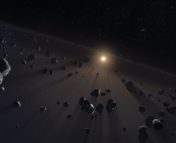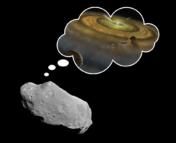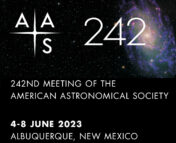Title: Anthropogenic Coal Ash as a Contaminant in a Micro-meteoritic Underwater Search
Author: Patricio A. Gallardo
First Author’s Institution: Kavli Institute for Cosmological Physics, University of Chicago
Status: Open-access at RNAAS
Cosmic litter is everywhere on Earth. During some of the most active yearly meteor showers, hundreds or thousands of meteors can be seen every night. These meteors, typically made of small dust grains from asteroids or comets, burn up entirely in the Earth’s atmosphere. However, especially bright meteors, called fireballs or bolides, are often caused by larger objects which may not be entirely destroyed during their fiery journeys and may leave fragments which reach the Earth’s surface. Most of these fragments are tiny, and these micrometeorites can even be found in most residential areas (Try collecting dust or dirt from a roof downspout or a gutter and run a magnet through it. Dark, round, pitted particles may be iron micrometeorites.).
However, it can be incredibly difficult to trace suspected extraterrestrial material and usually requires detailed imaging and chemical analyses to exclude Earth-based sources. Today’s research note highlights this problem as it applies to an especially high-profile example.
CNEOS2014
In 2014, a fireball of unusual brightness and speed was observed by US military automated monitors. In 2022, Amir Siraj and Avi Loeb proposed that this meteor originated from outside the solar system, based on the speed estimates logged in the Center For Near Earth Object Studies (CNEOS) fireball catalog as well as communications from the Department of Defense stating that their measurements were accurate and precise. While the specifics of this conclusion have been controversial, Loeb chartered a marine expedition to the Pacific Ocean through his Galileo Project to attempt to recover fragments of this meteorite and has since claimed an extrasolar origin for the small magnetic spherical particles the expedition collected.
This identification relies on the abundances of the elements beryllium, lanthanum, and uranium in these samples, which are significantly higher than those measured in C1 Chondrites, which have elemental abundances consistent with the Sun, and thus the elemental composition of the Solar System at its formation. Ignoring the difficulty of associating these specific samples with CNEOS 2014-01-08 nearly a decade post-event, have Solar System or terrestrial origins actually been ruled out for these samples?
Pesky Pollution
To answer this question, today’s author examines the measured elemental abundances in Loeb’s paper (which has yet to finish the review process and be published) and compares them to data from the US Geological Survey’s COALQUAL database. There is a well-established link between fossil fuel burning and climate change (just see previous Astrobites climate coverage for examples), but atmospheric carbon isn’t the only fossil fuel emission to worry about. Coal-fired powerplants also emit thousands of pounds of toxic heavy metals (like mercury) and radioactive materials, concentrating trace elements to levels not naturally seen. These elements can be measured directly from coal emissions, and it is these measurements which could make or break the interstellar meteorite hypothesis.
Figure 1: Measured elemental abundances from the Galileo Project expedition compared to measurements from samples in COALQUAL. The undersea samples are consistent with the coal ash distributions. Figure 1 in the paper.
The COALQUAL database contains elemental measurements for beryllium, lanthanum, and uranium (the three elements in question), as well as nickel and iron. In all cases, the measured Be/La/U/Ni abundances of the undersea samples are consistent with those in COALQUAL, while the Fe abundance is consistent with a separate historical study of coal ash samples. In addition, multiple 20th century marine expeditions have found particles similar to those recovered by Loeb’s Galileo Project expedition, and have consistently found that these samples are likely to be coal ash. Hundreds of years of coal-burning on land, as well as 150 years or more of coal-powered shipping directly in ocean environments means that these materials are likely to be globally distributed.
Galileo Under House Arrest?
While it appears these samples have a mundane, anthropogenic origin, don’t expect these efforts to end quietly. The hunt for extrasolar interlopers has been in full swing since the discoveries of 1I/’Oumuamua and 2I/Borisov, and if the activities of the Galileo Project are any indication, shows no sign of slowing down.
Featured image credit: Wikimedia Commons
Astrobite Edited by Cole Meldorf




